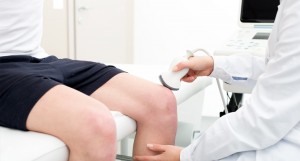Therapeutic ultrasound is an ultra-popular modality commonly used in physiotherapy clinics for the treatment of muscle injuries and sprains. However, despite its widespread use (and with that, the general assumption that it is clinically proven to accelerate healing), there have been no high level studies showing ultrasound to be more effective than placebo; that’s right, it may as well not be plugged into the wall!
So what is therapeutic ultrasound (TUS) exactly and how does it work? Therapeutic ultrasound has been around for a long time (since the 40s!) and works by shooting sound waves into the body at a frequency that cause a ‘mechanical’ vibration- if you have ever stood next to loud speakers and felt the vibration in your body, you would know how that might work. This supposedly ‘vibration therapy’ is basically a thermal agent that in theory, aims to change the temperature within the tissue to increase blood flow and cellular metabolism, much like a heat pack placed over a painful back.
 Now, doesn’t that sound fancy? Unfortunately, there has been little scientific evidence to support the use of TUS for musculoskeletal injuries. For example, this commonly heard physiotherapy myth that ‘TUS enhances recovery after ankle sprain’ has been publicly busted by the world’s largest physiotherapy clinical research website (PEDro), which showed a lack of efficacy and scientific basis for the proposed biophysical effects.
Now, doesn’t that sound fancy? Unfortunately, there has been little scientific evidence to support the use of TUS for musculoskeletal injuries. For example, this commonly heard physiotherapy myth that ‘TUS enhances recovery after ankle sprain’ has been publicly busted by the world’s largest physiotherapy clinical research website (PEDro), which showed a lack of efficacy and scientific basis for the proposed biophysical effects.
“There are downsides to just letting these myths live on. Spending time and money on treatment that does not work often means that people miss out on the things that would improve their health. So they suffer more than they need to,” Australian Physiotherapy Association member and PEDro Manager, Dr. Anne Moseley, concluded in the media release by the Australia Physiotherapy Association (2014).
Moving on. Where does it leave us then?
All in all, therapeutic ultrasound acts as an analgesic at best (much like a heat pack) and while you will agree this often feels nice, it does not promote tissue healing or address the underlying cause of the injury. Instead, such passive treatments may lead to increased treatment dependency, provide no long-term benefit and do nothing to treat the underlying problem.
Put it simply, therapeutic ultrasound is very unlikely to do you or your injury any harm. However, the main take-home message we’d like to leave you with is not whether TUS is good or bad for you, but whether it is the most effective and efficient treatment technique for the management of your injury.
At the end of the day, you should always consult your physiotherapist for the best evidence-based practice for the management of your injury.
Photo credit: http://www.advancedprofessionalimg.com/our-services/ultrasounds